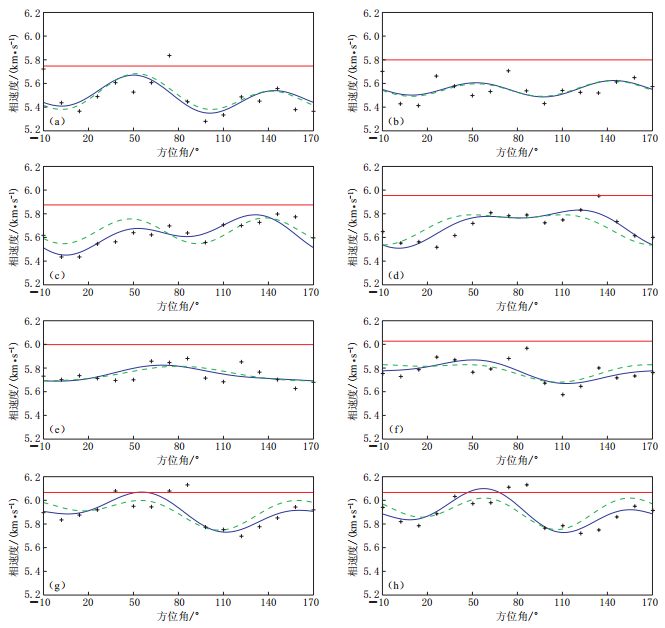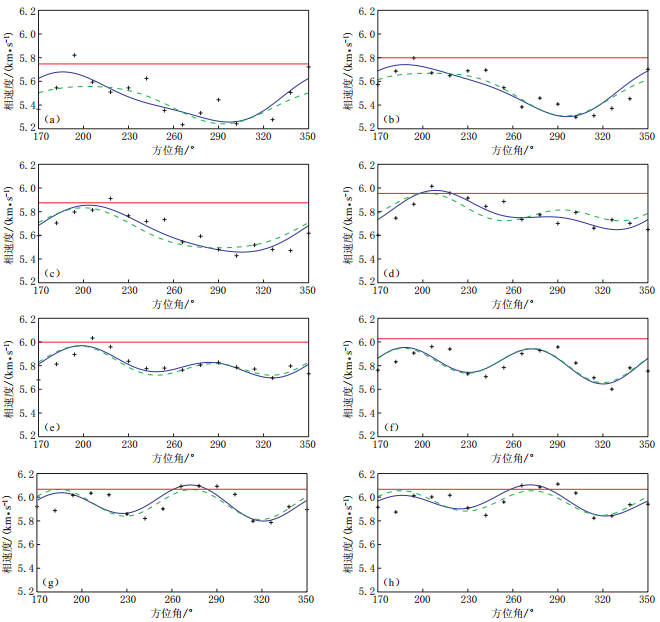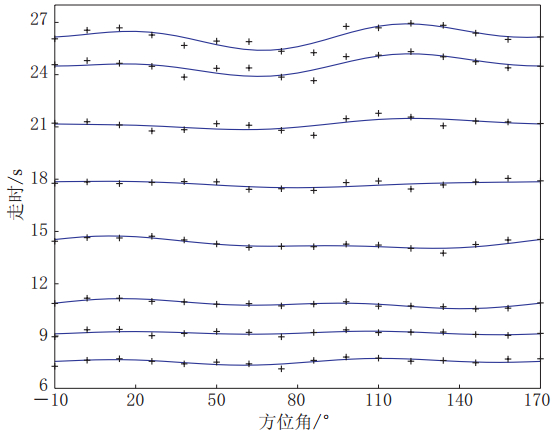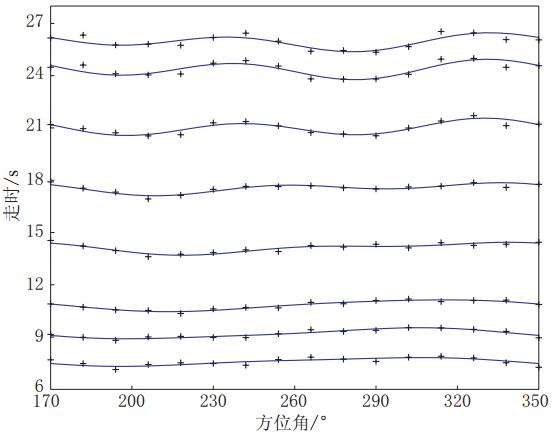Crustal anisotropy of Huailai--Yanqing region in North China
-
摘要: 提出了利用人工爆破P波走时反演地壳介质方位各向异性参数的方法. 在假定介质是弱各向异性介质的情况下, 使用扰动理论得到了线性化的反演公式, 其中待反演的弱各向异性参数是P波走时的线性函数. 如果在反演公式中参考走时取相同震中距接收点的P波平均走时, 那么所获得的弱各向异性参数与参考介质速度的选取无关. 反演得到的弱各向异性参数可以看作是不同震中距和不同深度范围内介质的等效弱各向异性参数. 等效弱各向异性参数在一定程度上反映了不同深度范围内水平方向相速度随方位的变化. 这种变化可能是不同时期构造应力作用的结果. 2007年中国地震局在首都圈怀来地区实施了一次大吨位人工爆破实验, 以爆破点为中心, 布设了高密度的地震观测台网和台阵. 台站相对于爆破点具有360°的全方位覆盖, 所得到的地震记录数据为研究怀来、 延庆地区地壳介质P波方位各向异性提供了必要条件. 我们通过走时反演获得了与水平方位相关的弱各向异性参数, 并对弱各向异性参数进行坐标变换, 得到了能够直观描述岩石弱各向异性的具有水平对称轴的横向各向同性介质, 给出了对应的3个独立弱各向异性参数及其对称轴方位, 讨论了介质各向异性与构造应力场的关系. 结果表明该地区地壳介质存在明显的方位各向异性, 其最大值约为4.6%.Abstract: A method for inversion of seismic anisotropy in crustal medium is presented by using the P-wave travel times from an explosive source. Perturbation theory is used to derive the linear inversion formulae when the medium is taken as a weakly anisotropic (WA) medium. The WA parameters in the formulae are a linear function of the P-wave travel time. The WA parameters are independent of the reference velocity when the reference travel time takes an average of P-wave travel times. The WA parameters from inversion can be considered as effective anisotropic parameters concerning the medium within different source-distances and different depths, which reflect the variation of phase velocity with azimuth. The azimuthal variation of phase velocity was probably caused by the tectonic force in different history periods. A large exploration was carried out in Huailai--Yanqing region near Beijing by China Earthquake Administration in 2007. A high density seismic network was deployed around the explosive point with azimuthal coverage of 360°, which provides an abundant data set for studying P wave seismic anisotropy of crustal medium. Travel time tomography in weakly anisotropic medium was used to calculate WA parameters. In order to get a comprehensive understanding of the studied medium, the inverted WA parameters were transformed to a new coordinate system related to a HTI (transverse isotropy with a horizontal axis of symmetry) medium. Three WA parameters and the orientation of symmetry axis of the medium were obtained. The relation of the WA parameters to tectonic stress field was discussed. The result shows that there exists an obviously azimuthal anisotropy (maximum 4.6%) in the crust of studied region.
-
Keywords:
- crust medium /
- anisotropy /
- seismic ray /
- travel time /
- inversion
-
-
图 3 W1区(-10°,170°)内与震中距40 km (a)、 50 km (b)、 60 km (c)、 80 km (d)、 100 km (e)、 120 km (f)、 140 km (g)和150 km (h)相对应深度内的等效介质相速度曲线
实线表示通过反演得到的一般弱各向异性介质的相速度; “+”表示由“观测”走时计算得到的相速度;虚线表示由坐标变换和最小二乘算出的相应的相速度; 红色直线代表P波相速度的参考各向同性速度
Figure 3. Effective phase velocity curves corresponding to different epicenter distances of 40 km (a),50 km (b),60 km (c),80 km (d),100 km (e),120 km (f),140 km (g) and 150 km (h) in the W1 area
Solid line denotes effective phase velocity from inversion of general weakly anisotropic media,cross denotes the result from the “observed” values,dashed line represents the phase velocity calculated by coordinate transformation and least squares fitting,and red straight line represents the reference velocity of P wave
图 4 W2区(170°,350°)内与震中距为40 km (a)、 50 km (b)、 60 km (c)、 80 km (d)、 100 km (e)、120 km (f)、 140 km (g)和150 km (h)相对应深度内的等效介质相速度曲线
实线表示通过反演得到的一般弱各向异性介质的相速度; “+”表示由“观测”走时计算得到的相速度;虚线表示由坐标变换和最小二乘算出的相应的相速度; 红色直线代表P波相速度的参考各向同性速度
Figure 4. Effective phase velocity curves corresponding to different epicenter distances of 40 km (a),50 km (b),60 km (c),80 km (d),100 km (e),120 km (f),140 km (g) and 150 km (h) in the W2 area
Solid line denotes effective phase velocity from inversion of general weakly anisotropic media,cross denotes the result from the “observed” values,and dashed line represents the phase velocity calculated by coordinate transformation and least squares fitting, and red straight line represents the reference velocity of P wave
表 1 W1区域(-10°,170°)内弱各向异性参数反演值
Table 1 Weak anisotropy parameters in the W1 area (-10°,170°)

表 2 W2区域(170°,350°)内弱各向异性参数反演值
Table 2 Weak anisotropy parameters in the W2 area (170°,350°)

表 3 整个区域内的反演的弱各向异性参数
Table 3 Weak anisotropy parameters in the whole area

-
戴维·布思, 王培德. 1997. 延庆-怀来盆地地震预测研究[J]. 国际地震动态, (3): 1-12. Booth D C, Wang P D. 1997. Earthquake predictions studies in the Yanqing-Huailai basin[J]. Recent Developments in World Seismology, (3): 1-12 (in Chinese).
高原, 郑斯华, 孙勇. 1995. 唐山地区地壳裂隙各向异性[J]. Acta Seismologica Sinica, 17(3): 283-293. Gao Y, Zheng S H, Sun Y. 1995. Anisotropy of crust cracks in Tangshan area[J]. Acta Seismologica Sinica, 17(3): 283-293 (in Chinese).
嘉世旭, 齐诚, 王夫运, 陈棋福, 张先康, 陈颙. 2005. 首都圈地壳网格化三维结构[J]. 地球物理学报, 48(6): 1316-1324. Jia S X, Qi C, Wang F Y, Chen Q F, Zhang X K, Chen Y. 2005. Three-dimensional crustal gridded structure of the Capital area[J]. Chinese Journal of Geophysics, 48(6): 1316-1324 (in Chinese).
金安蜀, 刘福田, 孙永智. 1980. 北京地区地壳和上地幔的三维P波速度结构[J]. 地球物理学报, 23(2): 172-182. Jin A S, Liu F T, Sun Y Z. 1980. Three-dimensional P velocity structure of the crust and upper mantle under Beijing region[J] . Chinese Journal of Geophysics, 23(2): 172-182 (in Chinese).
赖院根, 刘启元, 陈九辉, 刘洁, 李顺成, 郭飙, 黄志斌, 2006. 首都圈地区横波分裂与地壳应力场特征[J]. 地球物理学报, 49(1): 189-196. Lai Y G, Liu Q Y, Chen J H, Liu J, Li S C, Guo B, Huang Z B. 2006. Shear wave splitting and the features of the crustal stress field in the Capital Circle[J]. Chinese Journal of Geophysics, 49(1): 189-196 (in Chinese).
齐诚, 赵大鹏, 陈颙, 陈棋福, 王宝善. 2006. 首都圈地区地壳P波和S波三维速度结构及其与大地震的关系[J]. 地球物理学报, 49(3): 805-815. Qi C, Zhao D P, Chen Y, Chen Q F, Wang B S. 2006. 3-D P and S wave velocity structures and their relationship to strong earthquakes in the Chinese capital region[J]. Chinese Journal of Geophysics, 49(3): 805-815 (in Chinese).
孙若昧, 刘福田. 1995. 京津唐地区地壳结构与强震的发生: Ⅰ. P波速度结构[J]. 地球物理学报, 38(5): 599-607. Sun R M, Liu F T. 1995. Crust structure and strong earthquake in Beijing, Tianjin, Tangshan area: Ⅰ. P wave velocity structure[J]. Chinese Journal of Geophysics, 38(5): 599-607 (in Chinese).
孙若昧, 赵燕来, 吴丹. 1996. 京津唐地区地壳结构与强震的发生: Ⅱ. S波速度结构[J]. 地球物理学报, 39(3): 347-355. Sun R M, Zhao Y L, Wu D. 1996. Crust structures and strong earthquakes in the Beijing, Tianjin, Tangshan area: Ⅱ. S wave velocity structure[J]. Chinese Journal of Geophysics, 39(3): 347-355 (in Chinese).
吴晶, 高原, 陈运泰, 黄金莉. 2007. 首都圈西北部地区地壳介质地震各向异性特征初步研究[J]. 地球物理学报, 50(1): 209-220. Wu J, Gao Y, Chen Y T, Huang J L. 2007. Seismic anisotropy in the crust in northwestern capital area of China[J]. Chinese Journal of Geophysics, 50(1): 209-220 (in Chinese).
许向彤, 陈运泰, 王培德. 1997. 怀来盆地的构造应力场[J]. 地震地磁观测与研究, 18(1): 1-8. Xu X T, Chen Y T, Wang P D. 1997. Tectonic stress field in Huailai Basin[J]. Seismological and Geomagnetic Observation and Research, 18(1): 1-8 (in Chinese).
许向彤, 陈运泰, 王培德. 2001. 1995年7月20日怀来盆地ML4.1地震序列震源参数的精确测定[J]. 地震学报, 23(3): 225-238. Xu X T, Chen Y T, Wang P D. 2001. Precise determination of focal parameters for July 20, 1995 ML=4.1 earthquake sequence in the Huailai Basin[J]. Acta Seismologica Sinica, 23(3): 225-238 (in Chinese).
许忠淮, 刘玉芬, 张郢珍.1979. 京、 津、 唐、 张地区地震应力场的方向特征[J]. 地震学报, 1(2): 121-132. Xu Z H, Liu Y F, Zhang Y Z. 1979. On the characteristic of direction of the earthquake stress field around the Beijing area[J]. Acta Seismologica Sinica, 1(2): 121-132 (in Chinese).
Aki K, Christoffersson A, Husebye E S. 1977. Determination of the three-dimensional seismic structures of lithosphere[J]. J Geophys Res, 82(2): 277-296.
Aurenhammer F. 1991. Voronoi diagrams: A survey of a fundamental geometric data structures[J]. ACM Computing Surveys, 23(3): 345-405.
Babuska V, Cara M. 1991. Seismic Anisotropy in the Earth[M]. Dordrecht: Kluwer Academic Publishers: 1-3.
Backus G E. 1965. Possible form of seismic anisotropy of the upper-most mantle under oceans[J]. J Geophys Res, 70(14): 3429-3439.
Červený V. 2001. Seismic Ray Theory[M]. Cambridge: Cambridge University Press: 189-199.
Crampin S. 1978. Seismic-wave propagation through a cracked solid: Polarization as a possible dilatancy diagnostic[J]. Geophys J R astr Soc, 53(3): 467-496.
Crampin S. 1981. A review of wave motion in an isotropic and cracked elastic-media[J]. Wave Motion, 33(4): 43-91.
Crampin S, Evans R. 1985. Analysis of records of local earthquakes: The Turkish Dilatancy Projects (TDP1 and TDP2)[J]. Geophys J R astr Soc, 83(1): 1-16.
Dziewonski A M, Anderson D L. 1981. Preliminary reference Earth mode1[J]. Phys Earth Planet Inter, 25(4): 297-356.
Dziewonski A M, Anderson D L. 1984. Seismic tomography of the Earth's interior[J]. America Scientist, 72(5): 483-494.
Helbig K. 1993. Simultaneous observation of seismic waves of different polarization indicates subsurface anisotropy and might help to unravel its cause[J]. J Appl Geophys, 30(1/2): 1-24.
Hess H H. 1964. Seismic anisotropy of the upper mantle under oceans[J]. Nature, 203: 629-631.
Huang J, Zhao D. 2004. Crustal heterogeneity and seismotectonics of the region around Beijing, China[J]. Tectonophysics, 385(1/2/3/4): 159-180.
Jech J, Pšenčík I. 1989. First-order perturbation method for anisotropic media[J]. Geophys J Int, 99(2): 369-376.
Mensch T, Rasolofosaon P. 1997. Elastic wave velocities in anisotropic media of arbitrary anisotropy: Generalization of Thomsen's parameters, ε, δ and γ[J]. Geophys J Int, 128(1): 43-64.
Okabe A, Boots B, Sugihara K, Chiu S N, Kendall D G. 2000. Spatial Tessellations: Concept and Applications of Voronoi Diagrams[M]. Chichester: John Wiley & Sons, Inc., 1-671.
Pšenčík I, Gajewski D. 1998. Polarization, phase velocity and NMO velocity of qP waves in arbitrary weakly anisotropic media[J]. Geophysics, 63(5): 1754-1766.
Pšenčík I, Zheng X. 1998. Determination of Weak Anisotropy Parameters From the qP Wave Particle Motion Measurements, Seismic Waves in Complex 3-D Structures. Report 7[R]. Prague: Department of Geophysics, Charles University, 299-305.
Thomsen L. 1986. Weak elastic anisotropy[J]. Geophysics, 51(10): 1954-1966.
Zheng X. 2004. Inversion for elastic parameters in weakly anisotropic media[J]. Geophys J Int, 159(3): 1077-1089.
Zheng X. 2007. Identification of symmetry planes in weakly anisotropic elastic media[J]. Geophys J Int, 170(1): 468-478.
Zheng X, Pšenčík I. 2002. Local determination of weak anisotropy parameters from qP-wave slowness and particle motion measurements[J]. Pure Appl Geophys, 159(7/8): 1881-1905.





 下载:
下载:





